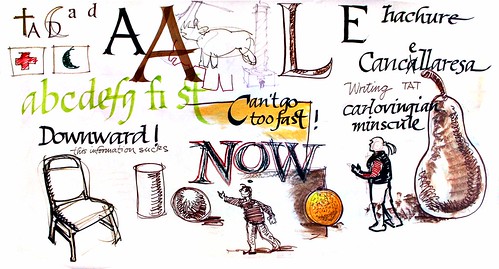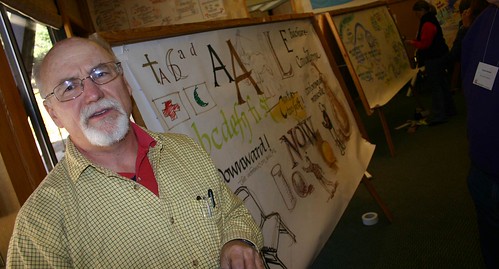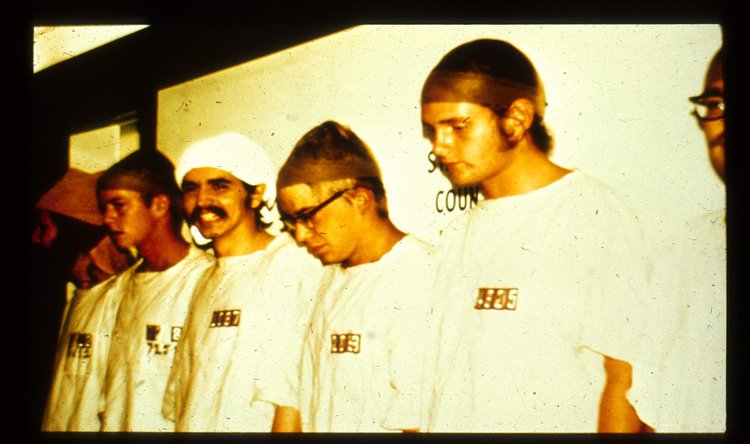IFVP 2006
/Below is a final list of posts capturing much of the conten from The International Forum of Visual Practitioner’s Conference 2006 in Lake Tahoe.
You can see the originals at the blog, The Center for Graphic Facilitation: http://www.graphicfacilitation.com
Special thanks goes out to all the organizers and lecturers who volunteered their time and energy to make this year a rich and rewarding experience for newbies and old-timers.
Perhaps a special recognition goes out to the group of US Coast Guard members who spent the weekend becoming comfortable with using pastels to defend the nation!
The decision isn't final, but things are looking good for next year's conference to be held in beautiful Santa Fe, New Mexico!
If you are interested in learning more about the IFVP or becoming a member, visit http://www.ifvp.org There is a whole lotta learning going on in Lake Tahoe! In one room, we have Newbies who are learning the basics of graphic capture. In the other room we have a group of "experienced" graphic professionals who are having their minds blown by the possibilities of emerging technologies. Click below to check out photos of the action...IVFP 2006: Photogallery
---------------------IFVP 2006: Evolution from Scribe to Strategy Partners Peter Durand of Alphachimp Studio Inc. presented a list of free (and almost free) tools for managing the business of the business of being a scribe.
The main messages:
- Success is dependent upon proving value to your client and their stakeholders.
- Mastering technology is a key differentiator.
- As small businesses, we need to improve the level of service and increase the efficiency of our back office processes.
Click link below for a list of the services and products reviewed...
Continue reading "IFVP 2006: Evolution from Scribe to Strategy Partners" »
Peter Durand of Alphachimp Studio Inc. presented a list of free (and almost free) tools for managing the business of the business of being a scribe.
The main messages:
- Success is dependent upon proving value to your client and their stakeholders.
- Mastering technology is a key differentiator.
- As small businesses, we need to improve the level of service and increase the efficiency of our back office processes.
Click link below for a list of the services and products reviewed...
Continue reading "IFVP 2006: Evolution from Scribe to Strategy Partners" »
---------------------Adkins' Calligraphy Pens Jan Adkins' workshop on letterforms introduced us to a fantastic set of calligraphy pens: Copic Markers.
They are refillable and affordable. Perfectly made for the human hand to hold super steady and produce large-scale letterforms.

Wide Set 12C
Price: $166.8
Jan Adkins' workshop on letterforms introduced us to a fantastic set of calligraphy pens: Copic Markers.
They are refillable and affordable. Perfectly made for the human hand to hold super steady and produce large-scale letterforms.

Wide Set 12C
Price: $166.8
---------------------Folk Art Letter Forms As graphic facilitators and illustrators, the history of lettering is a vast museum there for us to pillage. The front door is unlocked and the rewards are infinite! Here are a couple of examples of letter-looters and the whimsical results of their creative process:
 Ray Fenwick is an illustrator, artist, letterer and letterpress printer living in Halifax, Nova Scotia. His full-time day job is as manager for a soon-to-be-open letterpress printshop, so he wakes up early to work on Hall of Best Knowledge, an award-winning typographic comic. He makes all kinds of things, but to be honest, most of them include lettering in some way. His work has appeared in numerous exhibitions, and will soon be seen in Steven Heller's Old Type/new Type.
Ray Fenwick is an illustrator, artist, letterer and letterpress printer living in Halifax, Nova Scotia. His full-time day job is as manager for a soon-to-be-open letterpress printshop, so he wakes up early to work on Hall of Best Knowledge, an award-winning typographic comic. He makes all kinds of things, but to be honest, most of them include lettering in some way. His work has appeared in numerous exhibitions, and will soon be seen in Steven Heller's Old Type/new Type.
 Yee-Haw Industries has been covering America with unique, art-like products since 1996. Partners Kevin Bradley & Julie Belcher opened up shop from a back-40 barn in Corbin, Kentucky, with salvaged, antique equipment previously put to rust. Their vibrant, folk art, wood cut prints of country music's classic stars, such as Hank Williams, Sr. and Loretta Lynn, caught eyes and told stories. Handmade posters featured stranger-than-fiction characters, like ass-whooping grocer Cas Walker and daredevil icon Evel Kenevil. Soon, modern music acts, including Steve Earle, Buddy Guy, Trey Anastasio, Lucinda Williams and Southern Culture on the Skids began commissioning promotional posters and album art.
Yee-Haw Industries has been covering America with unique, art-like products since 1996. Partners Kevin Bradley & Julie Belcher opened up shop from a back-40 barn in Corbin, Kentucky, with salvaged, antique equipment previously put to rust. Their vibrant, folk art, wood cut prints of country music's classic stars, such as Hank Williams, Sr. and Loretta Lynn, caught eyes and told stories. Handmade posters featured stranger-than-fiction characters, like ass-whooping grocer Cas Walker and daredevil icon Evel Kenevil. Soon, modern music acts, including Steve Earle, Buddy Guy, Trey Anastasio, Lucinda Williams and Southern Culture on the Skids began commissioning promotional posters and album art.

In the early 1990s, renowned graphic designer Paula Scher began painting small, opinionated maps—colorful depictions of continents and regions, covered from top to bottom by a scrawl of words. Within a few years, the maps grew larger and more elaborate. “I began painting these things sort of in a silly way,” Scher, a partner at the Pentagram design firm, said in a recent conversation. “And I think at one point I realized they would be amazing big. And I wondered if I could even do it. If I could actually paint these things on such a grand scale, what would happen?”
See a beautiful video by Flash innovator, Hillman Curtis, of Scher describing her creative process and love of letter forms.
Here are a couple of examples of letter-looters and the whimsical results of their creative process:
 Ray Fenwick is an illustrator, artist, letterer and letterpress printer living in Halifax, Nova Scotia. His full-time day job is as manager for a soon-to-be-open letterpress printshop, so he wakes up early to work on Hall of Best Knowledge, an award-winning typographic comic. He makes all kinds of things, but to be honest, most of them include lettering in some way. His work has appeared in numerous exhibitions, and will soon be seen in Steven Heller's Old Type/new Type.
Ray Fenwick is an illustrator, artist, letterer and letterpress printer living in Halifax, Nova Scotia. His full-time day job is as manager for a soon-to-be-open letterpress printshop, so he wakes up early to work on Hall of Best Knowledge, an award-winning typographic comic. He makes all kinds of things, but to be honest, most of them include lettering in some way. His work has appeared in numerous exhibitions, and will soon be seen in Steven Heller's Old Type/new Type.
 Yee-Haw Industries has been covering America with unique, art-like products since 1996. Partners Kevin Bradley & Julie Belcher opened up shop from a back-40 barn in Corbin, Kentucky, with salvaged, antique equipment previously put to rust. Their vibrant, folk art, wood cut prints of country music's classic stars, such as Hank Williams, Sr. and Loretta Lynn, caught eyes and told stories. Handmade posters featured stranger-than-fiction characters, like ass-whooping grocer Cas Walker and daredevil icon Evel Kenevil. Soon, modern music acts, including Steve Earle, Buddy Guy, Trey Anastasio, Lucinda Williams and Southern Culture on the Skids began commissioning promotional posters and album art.
Yee-Haw Industries has been covering America with unique, art-like products since 1996. Partners Kevin Bradley & Julie Belcher opened up shop from a back-40 barn in Corbin, Kentucky, with salvaged, antique equipment previously put to rust. Their vibrant, folk art, wood cut prints of country music's classic stars, such as Hank Williams, Sr. and Loretta Lynn, caught eyes and told stories. Handmade posters featured stranger-than-fiction characters, like ass-whooping grocer Cas Walker and daredevil icon Evel Kenevil. Soon, modern music acts, including Steve Earle, Buddy Guy, Trey Anastasio, Lucinda Williams and Southern Culture on the Skids began commissioning promotional posters and album art.

In the early 1990s, renowned graphic designer Paula Scher began painting small, opinionated maps—colorful depictions of continents and regions, covered from top to bottom by a scrawl of words. Within a few years, the maps grew larger and more elaborate. “I began painting these things sort of in a silly way,” Scher, a partner at the Pentagram design firm, said in a recent conversation. “And I think at one point I realized they would be amazing big. And I wondered if I could even do it. If I could actually paint these things on such a grand scale, what would happen?”
See a beautiful video by Flash innovator, Hillman Curtis, of Scher describing her creative process and love of letter forms.
IFVP 2006: Jan Adkins on Symbols In order to bring your work to life, there are essential skills to creating and capturing ideas through icons, symbols and letterforms. Jan Adkins, professional illustrator and educator, demonstrated the evolution of signs and symbols from human experience.
Adkins says, "Our modern letter forms evolved from the symbols created by our ancestors, who drew meaning from natural forms."
For example, Apis the Bull => letter A
But he also laments, "Our cultural symbols have become more and more meaningful... and less and less meaningful. Mostly because the power and resonance has been lost over the years."
Over the course of two hours, Jan walked the group through the history of type from the Babylonians, Romans, Holy Roman Empire and Guttenburg.
So what is the key difference between icons and symbols?
- An icon is a graphic device that represents some object or action, the graphic device being ascribed symbolic meaning(s) beyond the object represented.
- A symbol has only the meanings abscribed to itself, representing only a concept and not recognizable as a particular object.
Read more for links, images and references to more on the history of images and lettering.
In order to bring your work to life, there are essential skills to creating and capturing ideas through icons, symbols and letterforms. Jan Adkins, professional illustrator and educator, demonstrated the evolution of signs and symbols from human experience.
Adkins says, "Our modern letter forms evolved from the symbols created by our ancestors, who drew meaning from natural forms."
For example, Apis the Bull => letter A
But he also laments, "Our cultural symbols have become more and more meaningful... and less and less meaningful. Mostly because the power and resonance has been lost over the years."
Over the course of two hours, Jan walked the group through the history of type from the Babylonians, Romans, Holy Roman Empire and Guttenburg.
So what is the key difference between icons and symbols?
- An icon is a graphic device that represents some object or action, the graphic device being ascribed symbolic meaning(s) beyond the object represented.
- A symbol has only the meanings abscribed to itself, representing only a concept and not recognizable as a particular object.
Read more for links, images and references to more on the history of images and lettering.
---------------------IFVP 2006: Keith Bendis, Basic Drawing  Many of us were crippled in Middle School when teachers began to teach that maturity means not drawing any more! At the IFVP 2006 conference, accomplish illustrator Keith Bendis, from Upstate New York, led a session for those fearful of drawing (especially in public!).
Many of us were crippled in Middle School when teachers began to teach that maturity means not drawing any more! At the IFVP 2006 conference, accomplish illustrator Keith Bendis, from Upstate New York, led a session for those fearful of drawing (especially in public!).
Participants rediscovered the freedom of marking marks without intention, creating images on demand, and creating stories from the resulting collage of images.
As Keith points out, "It is a lot easier with kids. Because they don't judge themselves so harshly."
Visit Keith's site: www.keithbendis.com
![]() Many of us were crippled in Middle School when teachers began to teach that maturity means not drawing any more! At the IFVP 2006 conference, accomplish illustrator Keith Bendis, from Upstate New York, led a session for those fearful of drawing (especially in public!).
Many of us were crippled in Middle School when teachers began to teach that maturity means not drawing any more! At the IFVP 2006 conference, accomplish illustrator Keith Bendis, from Upstate New York, led a session for those fearful of drawing (especially in public!).
Participants rediscovered the freedom of marking marks without intention, creating images on demand, and creating stories from the resulting collage of images.
As Keith points out, "It is a lot easier with kids. Because they don't judge themselves so harshly."
Visit Keith's site: www.keithbendis.com
---------------------IFVP 2006: Jan Adkins, Illustrator KEYNOTE SPEAKER
Jan Adkins is an illustrator, museum designer, educator and expert in the profession as an artist.
For nine years he was the associate art director at National Geographic Magazine, explaining the space shuttle, lasers, submarines, Soviet rockets, satellites, nuclear physics, marine archaeology, forest fires, volcanoes and the voyages of Christopher Columbus. Directing a team of researchers and doing original field research himself, he unraveled some of the most interesting topics ever addressed by Geographic during its golden age. Jan's job, according to his editor-in-chief Bill Garrett, "was like getting a doctorate every third month."
He has written scripts and treatments for the Discovery Channel, NOVA, and the BBC, and narrative voiceover for interactive corporate training programs. He taught editorial illustration at the Rhode Island School of Design for several years, and taught illustration and graphic design at Maryland Institute, College of Art, in Baltimore. He’s associated with several exhibit design firms and frequently consults on exhibits for zoos, art museums, science and natural history museums.
KEYNOTE SPEAKER
Jan Adkins is an illustrator, museum designer, educator and expert in the profession as an artist.
For nine years he was the associate art director at National Geographic Magazine, explaining the space shuttle, lasers, submarines, Soviet rockets, satellites, nuclear physics, marine archaeology, forest fires, volcanoes and the voyages of Christopher Columbus. Directing a team of researchers and doing original field research himself, he unraveled some of the most interesting topics ever addressed by Geographic during its golden age. Jan's job, according to his editor-in-chief Bill Garrett, "was like getting a doctorate every third month."
He has written scripts and treatments for the Discovery Channel, NOVA, and the BBC, and narrative voiceover for interactive corporate training programs. He taught editorial illustration at the Rhode Island School of Design for several years, and taught illustration and graphic design at Maryland Institute, College of Art, in Baltimore. He’s associated with several exhibit design firms and frequently consults on exhibits for zoos, art museums, science and natural history museums.
---------------------IFVP 2006: Spiral Dynamics Graphic facilitator, Brandy Agerbeck of Loosetooth.com, presented the basics of Integral Theory. This theory arises out of the body of work generated by philospher Ken Wilbur.
Graphic facilitator, Brandy Agerbeck of Loosetooth.com, presented the basics of Integral Theory. This theory arises out of the body of work generated by philospher Ken Wilbur.
---------------------The Great IFVP Tech Debate: When and What to Use The Tech Group at the IVFP 2006 conference is wrestling with technology. Within the group, there are folks who blog daily, are well-versed in digital photography, build PowerPoint presentations and live-or-die on the web.
Then there are those who are experts in the magic that happens when people gather together in person to tell strories and create large-scale maps and drawings.
Continue reading "The Great IFVP Tech Debate: When and What to Use" »
The Tech Group at the IVFP 2006 conference is wrestling with technology. Within the group, there are folks who blog daily, are well-versed in digital photography, build PowerPoint presentations and live-or-die on the web.
Then there are those who are experts in the magic that happens when people gather together in person to tell strories and create large-scale maps and drawings.
Continue reading "The Great IFVP Tech Debate: When and What to Use" »



















